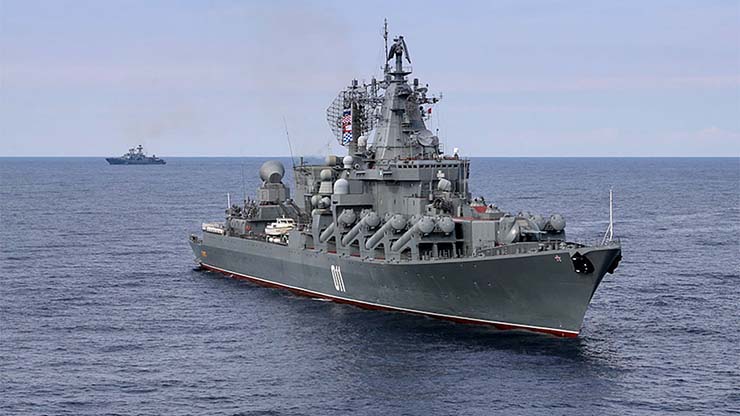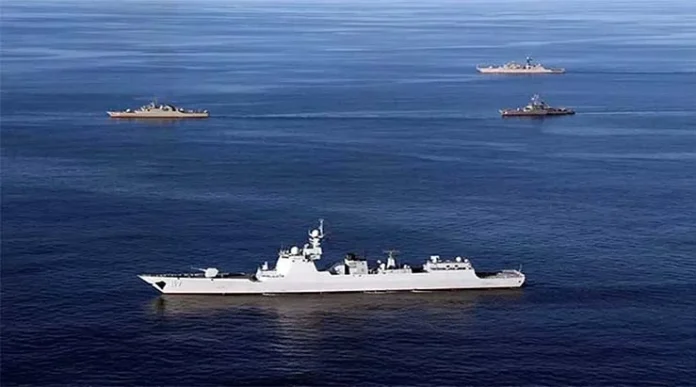The navies of Iran, China, and Russia held a naval exercise in the Gulf of Oman from March 11 to 15. This exercise, which saw the participation of surface and aerial units from the Iranian, Chinese, and Russian naval forces, was conducted with the objective of bolstering security measures and fortifying the foundations of stability in the region. The maritime exercise is named Security Bond-2024. According to Iranian media, the goal of this drill, apart from expanding multilateral cooperation among the participating countries, was to strengthen the security of maritime trade, combat maritime piracy and terrorism, undertake humanitarian measures, exchange information in the field of maritime rescue, and share operational and tactical experiences.
While the timing of this exercise may have coincided with the ongoing conflict in the Red Sea, the alliance between Iran, China, and Russia has been impacting the geopolitics of the Indian Ocean Region (IOR) beyond the recent instability. It is pertinent to consider the Iran-China-Russia partnership in the context of the geopolitics of the Indian Ocean and why it is important for the wider expanse of the Indo-Pacific Region.
There are three aspects to this naval exercise: Iran’s footprint in the Indian Ocean, power projection by China and Russia, and a relatively lesser focus on the Western Indian Ocean within the construct of the Indo-Pacific Region.
With the acknowledgment of the limitations of its own naval power, Iran has sought to align with the US’ adversaries like Russia and China to counter the influence of the US and Western powers in what it considers its sphere of influence, namely the Red Sea and the Indian Ocean
Iran’s Footprint in the Indian Ocean
From an international and regional perspective, Iran’s role is mostly considered from three angles. At the international level, Iran is perceived as an adversary of the United States (US) and other Western countries, mostly due to conflicting narratives regarding uranium enrichment. Iran maintains it is for peaceful purposes, while the West perceives it as building a nuclear arsenal. At the regional level, Iran is considered a power engaged in competition with other regional powers, such as the Arab countries, to secure the leadership position in the Islamic world. Through its proxies in Syria, Lebanon, and Yemen, Iran is constantly expanding its footprint and maintaining influence across the region to counter the overtures of Arab countries, particularly Saudi Arabia and the UAE. The third perspective is Iran’s geographical location, positioning it as a transit hub facilitating connectivity to landlocked Afghanistan and Central Asian countries, and vice versa. However, one of the lesser-focused but important areas is Iran’s maritime outreach in the Indian Ocean. Iran’s maritime forces consist of the Islamic Republic of Iran Navy (IRIN), the Islamic Revolutionary Guards Corps Navy (IRGCN), as well as the commercial shipping fleet, the Islamic Republic of Iran Shipping Lines (IRISL).
Iran’s primary maritime focus has been to protect its security interests in the Persian Gulf, the Strait of Hormuz, and the Gulf of Oman. Apart from maintaining a continuous presence in the Persian Gulf, Iran’s maritime objectives have included establishing a naval presence in the Red Sea and Gulf of Aden. The Red Sea is an important maritime route connecting the Mediterranean Sea, the Black Sea, the Atlantic Ocean, the Indian Ocean, and the Pacific Ocean. In the present context, Iran’s naval drills with Russia and China gain more significance as conflict between Iranian proxies, the Houthis, and Western powers is on the rise.
Iran’s maritime strategy includes the Mediterranean Sea as the primary radius and the Indian Ocean as the secondary radius. Outreach to the Mediterranean Sea is crucial for Iran to provide logistical support to pro-Iranian militias in Lebanon, Syria, and Palestine, while a presence in the Indian Ocean provides Iran with a transport route connecting to China.
While targeting the US and Israel is among the principal objectives of the Iranian naval forces, Iran’s strategy has tilted more towards asymmetric warfare. Following the Iran-Iraq war from 1980 to 1988 and the Operation Praying Mantis carried out by the US Navy in 1988, Iran reset its maritime strategy, realising that its naval forces were not suitable for direct confrontation with adversaries’ naval forces. Iran’s adoption of asymmetric warfare includes surprise attacks, ambushes, and hit-and-run operations. With the acknowledgment of the limitations of its own naval power, Iran has sought to align with the US’ adversaries like Russia and China to counter the influence of the US and Western powers in what it considers its sphere of influence, namely the Red Sea and the Indian Ocean.

China’s and Russia’s Power Projection
China and Russia are both non-resident powers in the Indian Ocean and are primarily dominant in the Pacific Ocean. Their conflict with the US conditions their engagements with Iran. In the past few years, as disputes between the US on one side and Iran, China, and Russia on the other side have grown, the latter three have forged strong relations at both bilateral and multilateral levels.
For China and Russia, Iran has emerged as a valuable partner in the Indian Ocean. Cooperation with Iran builds upon China’s and Russia’s existing footprint in the Indian Ocean. The two non-resident powers have had a long-standing presence in the IOR.
Regarding China, it has stepped up its presence in the Indian Ocean over the past three decades. China’s engagements, both strategic and economic, with the IOR include South Asia, Southeast Asia, and Africa. China’s Belt and Road Initiative (BRI) project has become an instrument not only for economic cooperation but also for strategic cooperation. Chinese investments in infrastructure projects, particularly port developments, mostly aim to create dual-use capabilities, implying that the ports could be used for both commercial and military purposes. Djibouti in Africa and Pakistan’s Gwadar Port are examples of China’s expanding outreach in the Indian Ocean. In March 2021, China signed an agreement with Iran to invest $400 billion in infrastructure projects in return for a steady supply of oil. This agreement would consolidate China’s foothold in the Indian Ocean while easing economic difficulties for Iran, which is reeling under sanctions.
For its part, Russia has also had a longstanding presence in the Indian Ocean. Besides naval drills with China and Iran, Russia has also conducted exercises with other Indian Ocean countries, including India. In recent times, Russian warships have visited Bangladesh, while Russia and Myanmar have held maritime exercises.
The impact of the recent Iran-China-Russia naval exercise must not be seen only as increasing complexity in the present conflict in the Red Sea. This trilateral cooperation has an impact beyond the limited geography of the Red Sea and across the Indian Ocean.
Western Indian Ocean in the Indo-Pacific Region
The Indo-Pacific Region, described by former Prime Minister of Japan Shinzo Abe as the confluence of two seas, the Indian Ocean and the Pacific Ocean, is projected as a mechanism for maintaining a rules-based order and freedom of navigation, implicitly countering China’s growing strategic assertion. As a countermeasure to China, the Quadrilateral Security Dialogue or the Quad, comprising India, the US, Japan, and Australia, has come to be associated with promoting and upholding the principles of a rules-based order and freedom of navigation.
However, the focus of the Quad has remained more on the Pacific component. Three of the four Quad partners, the US, Japan, and Australia, being Pacific countries, have often caused the grouping to focus on the Pacific side, including more attention to Southeast Asia and China’s assertion in the South China Sea.
Though not entirely neglected, the Western Indian Ocean has received relatively less attention from this grouping. India, for its part, has reached out to countries in the Western Indian Ocean and has been strengthening partnerships with them. These include the Gulf States and countries like Mauritius, Egypt, Kenya, and Seychelles, with which India has been strengthening its strategic and economic ties.
Countering China requires a concerted effort, which is one of the underlying objectives of the Quad. It is imperative that the Quad recalibrates its focus on the Western Indian Ocean. Several countries, particularly African countries, depend on economic assistance from their partners for infrastructure development. China is already the highest source of foreign direct investment in Africa. Compared to China’s footprint, the Quad’s outreach to the Western Indian Ocean still remains at a sub-optimal level.
While Iran’s own naval power and outreach across the Indian Ocean may have its limitations, cooperation with China and Russia amplifies its presence across the Indian Ocean. The impact of the recent Iran-China-Russia naval exercise must not be seen only as increasing complexity in the present conflict in the Red Sea. This trilateral cooperation has an impact beyond the limited geography of the Red Sea and across the Indian Ocean.
-The writer is an Independent Political Analyst and Researcher based in Vadodara. Follow him on X: @NiranjanMarjani. The views expressed are of the writer and do not necessarily reflect the views of Raksha Anirveda
–The writer is an Independent Political Analyst and Researcher based in Vadodara. Follow him on Twitter: @NiranjanMarjani. The views expressed are of the writer and do not necessarily reflect the views of Raksha Anirveda






